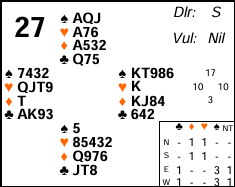City and Canada Bay – Thursday Morning 21st November 2024.

Each side had 20 points on board 27 last week. As is so often the case, however, the pairs that competed more aggressively to win the part score tended to come out on top.
Most auctions will have started P P to North – although it’s conceivable some Wests will have opened, either a very aggressive 1♣ with only 10 points or perhaps they had a bid available to show both majors (which will lead to East West playing in spades).
Normally, however, North will open 1NT (15-17). At a lot of tables it looks like East passed, South transferred to his heart suit and that was it – North ended up playing in 2♥. South definitely should transfer even with 5 such dreadful hearts – think how much more his hand is worth with hearts as trumps than in no-trumps. Also, his partner could have a fit for hearts and it will then play much better than no-trumps. There is a lot more upside than downside by transferring.
2♥ -1 by North was a common score on the hand – declarer is going to lose 3 trumps, ♣AK and at least 1 diamond. Even if East makes an unfortunate spade lead round to the ♠AQJ it doesn’t make much difference – declarer now has a discard available on the ♠A but it doesn’t really help him. Discarding a club from South is pointless as he will still have 2 club losers anyway, so declarer might as well discard a diamond. Now he will start drawing trumps and, although they split badly, he remains in control and can play on the minor suits and leading towards the ♦K leads to 7 tricks. With such bad hearts some declarers may be reluctant to play on trumps but that’s wrong – you still have more than the opponents and if you don’t try to get theirs out of the way they will just trump your later winners! See advanced section for some tips on how to play poor suits like this.
Deep Finesse of course shows that East West can make 3♠. Therefore the pairs that did better were the ones who got involved in the auction to either play in spades, or push North South higher. East is the best placed to do this. After North opens 1NT there is definitely some risk in overcalling – after all South could have the 10 points not West(!) and neither of East’s suits are particularly good on their own. There are all sorts of bidding methods available over 1NT – as usual each method will work well on some hands and less well on others. So what’s more important is that you and your partner agree on one and both know it, rather than exactly what it is. It is useful to have a bid to show both majors but, beyond that, it really doesn’t much matter what you play. Many methods focus on two suiters so you might be able to bid 2♠ showing spades and a minor, or perhaps bid 2♦ showing spades and another suit. Of course whenever East does bid and show spades, West will be very happy to bid to at least 2♠ and possibly higher given his shape. The fact that East West have the spade suit makes it attractive to compete – because they can outbid the opponents at the same level (i.e. they can bid 2♠ over 2♥ and the opponents would now have to go to 3♥ to outbid them).
If East doesn’t bid immediately (an action with which I have plenty of sympathy – it could go horribly wrong!) then he does have another chance. The auction is likely to continue 2♦ (transfer) P 2♥ back to him. At this point he could wade in – either with 2♠ or with double (takeout of hearts). I prefer acting at this point to doing so immediately – see advanced section for why and also why this vulnerability is especially good for competing.
2♠ plays pretty well for East West. If East is playing it, South may lead a heart which will immediately set up some heart winners in dummy. Declarer should end up losing 2 trumps, and both red aces. If West is playing it, North has a pretty horrible lead and is most likely to lead a club (process of elimination – leading or underleading unsupported aces is far more often wrong than right so the club is the least bad option). After declarer wins the 1st club what should he do? The answer is play on hearts (BEFORE touching trumps). Why? Because if you play trumps when the defence get in they will play a 2nd club which knocks out your ♣K which will expose a club loser – and you still haven’t knocked out their ♥A. So you need to set some heart winners up in the West hand first to be ready to discard that club loser from the East hand. Trumps will have to wait.
Key points to note
Competing to play the part-score is essential to doing well in bridge. It’s especially valuable when you have spades as you can outbid the opponents at the same level.
Consider what the opponents have shown in the auction – it may be dangerous to wade in initially but later in the auction it may be safer now you know more what they have shown.
Leading or underleading aces against a suit contract (at least one below the 5 level) is generally a bad choice – it will cost a trick a lot of the time. Prefer another suit.
If the defence have attacked your weak spot, there may be more urgent things to do before drawing trumps (e.g. set a discard up for a potential loser).
With a trump suit where you only have the ace, ducking a round and taking the ace on the 2nd round is often a good play to keep control and stop the opponents drawing more rounds of trumps than you want.
Neither side vulnerable is known as the “bidders vulnerability” – the mathematics of bridge scoring at pairs makes it more attractive to compete more aggressively to try and play the hand.
More advanced
Sometimes you find your playing with a relatively bad trump suit. It’s frequently still right to play the suit because you need to attempt to draw trumps – even with bad trumps, if you have an 8 card fit you will often be able to get rid of the opponents in 3 rounds. Things can, however, go badly if suits break poorly. Also you may want to be ruffing losers before you complete drawing trumps so you don’t want the opponents being able to play more rounds than necessary. There are techniques, therefore, to help with this. The heart suit on this hand is one example – a very similar situation is if you have Axxx opposite xxxx. Even if the suit breaks 3-2 you are going to lose 2 trumps. But if you play A and another, the opponent with 3 trumps may be able to draw a 3rd round and that will take two more of yours leaving you with only one in each hand. You frequently want to avoid that 3rd round of trumps being played – and instead just leave the opponent with a winner that he will have to ruff in with at some point. The best play in such a suit is therefore often to duck the first round completely. Now cash the A on the 2nd round. If the suit splits 3-2, that just leaves 1 trump out but the opponent is not in a position to play it because you are on lead. You therefore still have 4 trumps which you can use for ruffing. That can also work better if the suit splits poorly. Releasing the A immediately could then lead to the opponents being able to draw all 4 rounds of trumps! Ducking and winning the A on the 2nd round will leave one opponent with 2 trumps but at least he isn’t on lead to be able to draw all your remaining trumps! You may instead be able to play winners and he will have to ruff in which means he could then only draw one round – this enables you to keep better control of the hand.
I said I slightly preferred waiting on the East hand over 1NT and instead taking action after 2♦ P 2♥. It is a bit risky to wade in over 1NT because, even though South is a passed hand, there’s a known strong hand on your right and South can still have 10 points with spades or diamonds sitting over you. So you could get into big trouble After the auction has continued 2♦ P 2♥ it’s now a bit different. Two reasons for acting at this point are:
a) Once South has shown 5 hearts, that reduces the chances that he has a nasty spade or diamond holding sitting over your hand! So that makes it a bit safer to come in.
b) Because South passed initially there is a good chance that the 2♥ bid is going to be passed – hence if we are going to compete this is our last chance. Partner is likely to be sitting with quite a few hearts so he won’t easily be able to act – we have the heart shortage so we should be acting (either with 2♠ or a takeout double – both will work well here).
At pairs when both sides are non-vulnerable it is the best time to compete in the auction. That’s because the scoring works in your favour if you declare rather than defend. Even if your contract is going 1 or 2 off, that will score -50 or -100 which is better than conceding -110 or -140 when their contract is making. Likewise if their contract is going off you are only collecting +50 or +100 when you could perhaps be making +110 or +140 if you play the hand. Compare this to the difference when either or both sides are vulnerable. If you are vulnerable any undertricks cost 100 so competing is less attractive – especially if you might go for -200. For the same reason if they are vulnerable it’s more attractive to defend as you might score +200. Many people assume that vulnerable against not is the worst time to compete but that’s not actually the case – both sides vulnerable is worse (because this time not only are you risking -200 yourself by competing too high but you might be passing up the opportunity of collecting +200 from them).
Julian Foster (many times NSW representative) ♣♦♥♠



